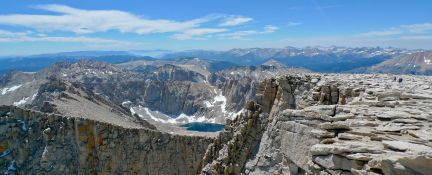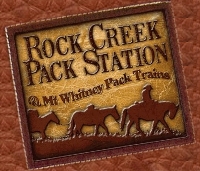
ROCK CREEK PACK STATION (760)872-8331
Trip Overview:
Wallace Lake is one of the Sierra backcountry gems that are bypassed as backpackers rush along the John Muir/Pacific Crest Trail. You might see another person, as you drop your line into the lake, but probably not. Add walking to the top of the contiguous United States, Mt. Whitney, the easy way and you have a trip you will reminisce over for years. We will carry your gear, set up camp every night, and prepare delicious meals as you travel through meadows and forests, rest by cascading streams, and enjoy panoramic views of the magnificent Sierra.
Arrive at Cottonwood Pack Station by 7:00 AM where your gear will be weighed and you will be served breakfast. Your personal vehicles will be left in the Cottonwood Pack Station parking area.
In and Out Horseshoe Meadow
Hikers should be able to walk 13 miles, 3,000 elevation gain and loss. You should acclimate to at least 8,000 to 10,000 for 1-3 days prior to the trip.
Distance: 36 miles with a total gain of 6,450 feet, and a total loss of 9,200 feet.
Elevation Profile:

Day 1: Horseshoe Meadow over Cottonwood Pass to Chicken Spring Lake
4.8 miles, 1,400 gain, 215 loss
The day will start with a 7:00 breakfast at Cottonwood Pack Station. The walk begins by descending 0.3 miles to the trail and then ascends gently beside the meadow for a mile before entering open forest to climb steadily to 11,160 Cottonwood Pass by mile 4.1. We will turn north onto the Pacific Crest Trail, walking another half mile before leaving the trail to follow the creek a short distance up to Chicken Spring Lake.
There is no reliable water beyond Horseshoe Meadow until Chicken Spring Lake.
Day 2: Chicken Spring Lake to Lower Rock Creek
9.4 miles, 550 gain, 2,300 loss
Returning to the Pacific Crest Trail, the path climbs briefly, gaining 500 in the first mile, and then undulates along the side of the mountain with good views of Big Whitney Meadow to the left. The trail enters Sequoia National Park in three miles, dropping steadily through open forest the rest of the day, passing the Siberian Pass junction at mile four and the Upper Rock Creek Trail junction at mile 8.5. The path will finally cross Rock Creek and then leaves the Pacific Crest Trail to follow a use path a short distance down the north side of the creek to our camp alongside a beautiful meadow edged by the creek. The creek crossing might be tricky if there has been recent rain.
Most of the seasonal streams in this area will be dry with no reliable water until we approach Rock Creek at the end of the day. Be sure to leave Chicken Spring Lake with plenty of water.
Day 3: Lower Rock Creek to Wallace Creek
10.3 miles, 2,800 gain, 1,700 loss
The day starts with a steady climb out of the Rock Creek drainage to Guyot Pass, 1,400 in 2.5 miles. Dropping down from the pass, the route traverses the hillside on a sandy trail. Twisted foxtail pines frame views of Red Spur across the Kern Canyon. There is a brief climb into the Whitney Creek drainage, before the trail drops 500 to the Whitney junction near the creek, which is about six miles from our camp. Continue straight on the Pacific Crest Trail 0.7 miles to the junction with the John Muir Trail. Follow the combined PCT/JMT trail north as it skirts the east side of Sandy Meadow with views to the west of Red Spur, then climbs a low ridge before dropping 600 to Wallace Creek. A use path follows the creek east about 0.5 miles to our camp in Wallace Meadow.
There is fairly reliable water about a mile out of camp, with the next reliable water at Whitney Creek, 6 miles from the Rock Creek camp.
Day 4: Layover Day Wallace Lake
6 miles round trip, 900 gain and loss
Wallace Lake is a beautiful lake nestled in a bowl surrounded by 1,500 stone walls on one side and meadows on the other. The lake is considered one of the best fishing lakes in the Sierra. The route follows an unmaintained trail through open forest along the north side of the Wallace Creek to the meadow where the outlet creek from Wales Lake joins Wallace Creek. Old maps show a route that follows the north side of Wallace Creek all the way to the lake, but many people cross Wallace Creek and the Wales Lake outlet creek at the meadow to follow Wallace Creek on the south side of the creek to the upper meadow. Cross to the trees on the north side to climb around the side of the rock face to access the lake. Be sure to spend some time at the pond just below the outlet of the lake if you are fishing.
Water is readily available throughout the day.
Day 5: Wallace Creek to Guitar Lake
7.4 miles, 1,800 gain, 850 loss
Return to the John Muir Trail, turning south to cross Wallace Creek. The path climbs 600 in 1.6 miles before dropping gently to skirt Sandy Meadow and then ascends a 200 ridge to the junction where the John Muir Trail leaves the Pacific Crest Trail. Go left to follow the John Muir Trail toward Mount Whitney. Continue straight in 0.8 miles at the Crabtree Meadow junction, leaving the trees at Timberline Lake and finally stopping at our camp above Guitar Lake. Mount Whitney towers 3,000 above the lake to the east.
Day 6: Layover day climb Mount Whitney, if desired
12.9 miles, 3,150 gain, 4,250 loss
Mount Whitney provides several hours of shade after sunrise making the long climb to the top in the treeless landscape less daunting, so plan to leave camp at dawn. The early departure will also let you beat the crowds to the top. The trail starts off to the southeast for about a mile before starting to climb the steep wall on long switchbacks, gaining 2,100 in 2.9 miles. Look across Hitchcock Lakes to Mount Hitchcock to gage your progress up the mountain, as Trail Junction, at 13,650 feet, is only 450 above Mount Hitchcock. Go left at the junction below Trail Crest to follow the fairly narrow trail cut into the rock on the west side of the pinnacles. There are several windows providing stunning views to the east. Another 1.9 miles and almost 900 elevation gain takes you to the top. Camp will be at Guitar Lake or Crabtree Meadow for this night. Enjoy your time at 14,505 feet before retracing your steps past Guitar Lake to Crabtree Meadow. Timberline Lake is a great spot to rest and soak your feet. Leave the John Muir Trail at mile 12.3 to follow the trail to Crabtree Meadow. Crabtree Meadow Camp is across the stream about ½ mile below the junction.
There is no reliable water between Guitar Lake and the top of Mount Whitney.
Day 7: Crabtree Meadow/Guitar Lake to Upper Rock Creek
9.9 miles, 1,850 gain, 1,800 loss
Follow the trail southwest for ½ mile past lower Crabtree Meadow to the junction with the Pacific Crest Trail. Check your water here, because there is little reliable water for the next 5.6 miles. The trail now climbs steadily to gain 500 in the first mile and then traverses the hillside on a sandy trail for 2.3 miles, dropping 200 before climbing 450 to Guyot Pass. The path then drops 1,400 in 2.3 miles to cross Rock Creek. The trail climbs out of the drainage to the Rock Creek/Army Pass Trail junction in 1.1 miles. Go left at the junction to follow the creek through forest and meadows for 2.6 miles to Rock Creek Lake. Camp is in the trees at the east end of the meadow surrounding the lake.
Day 8: LAYOVER at Upper Rock Creek
This camp is an excellent choice for a layover day. Miter Basin and Mt. Langley are both outstanding side trips from this camp.
There is little reliable water between the Crabtree Meadow junction and Rock Creek. Water is readily available in normal water years as the trail follows Rock Creek to camp.
Day 9: Upper Rock Creek to Horseshoe Meadow
11 miles, 1,500 gain, 1,935 loss
Follow the trail up to the Soldier Lake junction, 400 in ½ mile. Turn right and follow the path past the junction of New Army Pass, mile 1.1, to the Pacific Crest Trail at mile 2.2. Go left at the junction toward Cottonwood Pass to travel through open forest past Chicken Spring Lake to the pass, mile 6.8. Leave the Pacific Crest Trail toward Horseshoe Meadow, dropping 1,300 in 3.8 miles to the pack station.
The only reliable water is at Chicken Spring Lake.
While the packers will follow the Cottonwood Pass route, an alternate route for hikers is over New Army Pass, 12.5 miles with a 1,750 gain and 2,100 loss.
SOME LAYOVER DAY OPTIONS:
Miter Basin, accessible from Upper Rock Creek Camp
6.0 miles, 1,100 gain and loss
There is an unmaintained trail that follows Rock Creek into Miter Basin from near the small lake. The trail climbs through open forest to a large meadow and then continues up the basin to a mix of slick rock and meadow where you are surrounded by 13,000-14,000 peaks, about two miles and 700 elevation gain. You can follow the drainage up an additional mile and 400 elevation gain to beautiful Sky Blue Lake. Other lake basins and Crabtree Pass (12+ miles round trip, 2,400 gain and loss) are options. Your distance depends on how far you elect to venture into the basin.
Water is readily available in Miter Basin in normal rain years.
Summit Mt. Langley
11+ miles, 3,700 gain and loss
To travel to the top of Mt. Langley, return to the Rock Creek Trail past the Soldier Lake junction and then turn left at the junction to New Army Pass. Ascend toward New Army Pass, watching for an unmaintained trail to (Old) Army Pass on the left. Turn north and ascend the scree and gravel on the south slopes of Mount Langley. The slope gets steeper towards the end. The easiest route is found by skirting the summit plateau slightly to the left to avoid the steep rock straight ahead. Once the plateau is reached, travel straight north, and when you reach the steep North Face of Langley, turn right and head west toward the summit. The summit is an unimpressive platform of sand and rocks, but the views in all directions are amazing. Source: summitpost.org.
Water is available to Soldier Lake and may be available part way up the New Army Pass Trail.
| Location | Daily
Distance | Cumulative
Distance | Elevation |
| Horseshoe Meadows | | 0.0 | 10,065
| | AP Junction | | 0.3 | 9,950
| | Golden Trout Lakes Junction | | 1.1 | 9,960
| | Cottonwood Pass | | 4.1 | 11,160
| | Chicken Spring Lake Junction | | 4.7 | 11,230
| | Chicken Spring Lake Campsite | 4.8 | 4.8 | 11,250
| | Chicken Spring Lake Junction | | 4.9 | 11,230
| | Enter Sequoia National Park | | 8.1 | 11,350
| | Siberian Pass Trail Junction | | 8.9 | 11,060
| | Start of steeper downhill | | 10.8 | 10,940
| | Army Pass Trail Junction | | 13.2 | 9,820
| | Rock Creek Crossing | | 14.3 | 9,573
| | Lower Rock Creek Campsite | 9.6 | 14.4 | 9,550
| | Rock Creek Crossing | | 14.5 | 9,550
| | Guyot Pass | | 16.8 | 10,900
| | Crabtree Meadow Junction | | 20.1 | 10,320
| | John Muir Trail Junction | | 20.8 | 10,780
| | High Sierra Trail Junction | | 24.2 | 10,410
| | Wallace Creek Meadow Campsite | 10.3 | 24.7 | 10,600
| | High Sierra Trail Junction | | 25.2 | 10,410
| | Pacific Crest Trail Junction | | 28.6 | 10,780
| | Crabtree Meadow Trail Junction | | 29.4 | 10,640
| | Timberline Lake | | 31.0 | 11.220
| | Guitar Lake Campsite | 7.4 | 32.1 | 11,550
| | Trail Junction | | 35.0 | 13,650
| | Mount Whitney | | 36.9 | 14,510
| | Trail Junction | | 38.8 | 13,650
| | Guitar Lake | | 41.7 | 11,520
| | Timberline Lake | | 42.8 | 11,110
| | Crabtree Meadow Trail Junction | | 44.40 | 10,640
| | Crabtree Meadow Camp | 12.9 | 245.0 | 10,450
| | Pacific Crest Trail Junction | | 45.5 | 10,320
| | Guyot Pass | | 48.8 | 10,900
| | Rock Creek Crossing | | 51.1 | 9,550
| | Army Pass Trail Junction | | 52.2 | 9,820
| | Miter Basin Junction | | 54.8 | 10,470
| | Upper Rock Creek Camp | 9.9 | 54.9 | 10,500
| | Soldier Lake Junction | | 55.5 | 10,720
| | New Army Pass Junction | | 56.1 | 10,940
| | Pacific Crest Trail Junction | | 57.2 | 11,060
| | Leave Sequoia National Park | | 58.1 | 11,350
| | Crossing below Chicken Springs Lake | | 61.2 | 11,230
| | Cottonwood Pass | | 61.8 | 11,160
| | Cottonwood Pack Station/Horseshoe Meadow | 11.0 | 65.9 | 10,065
|
Please note that this represents the planned itinerary. Weather or other factors may affect the choice of campsites and daily travel. All decisions are made by the Head Packer with attention to the safety and comfort of guests and stock.
Expected Campsite Locations
| Day | To | Elevation | Latitude N | Longitude W | Miles | Gain | Loss |
| 1 | Chicken Spring Lake | 11,250 | 36.456 | 118.226 | 4.8 | 1,400 | 215 |
| 2 | Lower Rock Creek | 9,500 | 36.496 | 118.338 | 9.6 | 550 | 2,300 |
| 3, 4 | Wallace Creek Meadow | 10,600 | 36.600 | 118.363 | 10.3 | 2,800 | 1,700 |
| 5 | Guitar Lake | 11,550 | 36.572 | 118.313 | 7.4 | 1,800 | 850 |
| 6 | Crabtree Meadow | 10,450 | 36.446 | 118.353 | 12.9 | 3,150 | 4,250 |
| 7 | Upper Rock Creek | 10,500 | 36.495 | 118.280 | 9.9 | 1,850 | 1,800 |
| 8 | Horseshoe Meadow | 10,065 | 36.451 | 118.172 | 11.0 | 1,500 | 1,935 |
| Total | | | | | 65.9 | 13,050 | 13,050 |
*Mileage is based on Tom Harrison maps. Gain, and loss is based on Gaia GPS and Guthooks PCT Hiker applications.
What you need to know
for hikers on pack stock supported trips
Dunnage limit is 30 lbs. per person (this includes sleeping bags, fishing equipment, liquor, etc.)
You may bring your own tent up to 10 pounds that is in addition. The PCT 28 day trip allows 35 pounds of duffel.
PERSONAL CHECK LIST
Bring belongings in stout canvas or nylon duffels; side zipper recommended, ideal size approximately 14" x 32". It is a good idea to use a large plastic bag INSIDE of the duffle to protect contents from external moisture.
Sleeping bags can be in separate duffels --again, line the inside of the duffle against rain.
Place all cosmetics, soaps, medications, etc into small plastic containers with close-fitting caps, THEN into sturdy resealable plastic storage bags. If anything breaks or bursts from altitude changes, the plastic bag contains the spill.
When possible, it is a good idea to transfer alcoholic beverages to sturdy plastic bottles with well fitting caps - it will save weight and protect against breakage.
ESSENTIALS
- Footwear. For this trips a medium-weight pair of hiking boots. We
do not recommend lightweight hikers or tennies since they give
little ankle support and the soles are often thin.
- Camp Shoes. A lightweight pair of tennies or Tevas to wear in
camp. This will reduce vegetation damage at our campsites.
- A day pack. It should be large enough to take water, extra clothing, rainwear,
camera, etc during the days.
- Sleeping Bag. Most summer trips are warm and a bag rated to
about 25°F will be plenty warm enough. We much prefer down
bags, and good quality ones at that. Your bag should weigh in
around 3 pounds.
- Sleeping pad. A 3/4 or full length closed cell foam or Thermarest.
If you bring a Thermarest also bring a repair kit to fix pesky holes!
- Coffee mug (plastic for camp)
CLOTHING
- 2 pair synthetic liner socks.
- 2 pair heavier synthetic or wool blend socks.
- Long underwear top. Capilene, some other synthetic or the new
pure Merino wool types.
- Long underwear bottom.
- Warm pants. Tights or Expedition Weight Capilene.
- Warm shirt. Synchilla or R2 weight works well.
- Another fuzzy sweater top or pile jacket of some sort
- GoreTex Jacket and Pants. A lightweight set is sufficient and heavy
bulky clothing is unnecessary. Side zips on the pants should be
long enough to slide over boots. Jacket must have a hood. Do not
skimp on your rain gear. Nylon ponchos are not acceptable.
- Shorts for on the trail
- Tee shirt for on the trail
- Lightweight capilene or similar gloves.
- Warm hat. Synthetic or wool.
- Sunhat
ETC.
- Sun glasses.
- Water Bottles. Two quart (1 liter) wide mouth bottles and/or a hydration
system holding up to 50oz. (2 liters). Dont bring bike bottles or
any bottle that doesnt have a wide opening.
- Headlamp. --and a spare set of batteries!
- Pocket knife. Swiss army style.
- Personal toiletries. It is not necessary to smell like a rose each day
so do not over do it.
- Ear plugs are great to have in a noisy tent.
- Personal Medical Kit. The guide will carry a large kit so yours will
predominately consist of foot repair items, mild pain killer such as
Advil and bandaids.
- Sunscreen and lip screen. SPF 30+. A 1oz. bottle will be enough.
Make sure the lip stuff actually contains a sunscreen.
- Bug repellent.
- Camera. A spare battery and card are good backups
- Ski/trekking poles. These are not essential, but can be handy on
the trail. It is your choice, but they do save wear on the knees.
- Plastic trash bag. Handy for keeping gear in outside the tent
should it rain.
- Optional reading material, etc.
FOOD
We provide the all meals on scheduled trips. You can bring
your favorite "on-the-trail" snacks.
OPTIONAL ITEMS
- Small notepad and pencil
- Collapsible plastic wash basin (optional)
- Solar shower (optional)
- Water filtering pump (optional)
- Liquor (be sure to check in with the packers to see that your liquor is packed safely)
- Fishing equipment (optional)
- Rod/reel/line (a rod that breaks down into 3 or more pieces is recommended)
- Compact metal rod case to carry on saddle
- Canvas creel (no tackle boxes)
- Leader material (1-3 lb.)
- Flies: black gnat, mosquito, grey hackle, brown hackle, & royal coachman (No. 12-14 hooks)
- Bait: worms & Pautzke red eggs
- Egg hooks, worm hooks (No. 10-14)
- Split shot
- Lures (personal choice)
- Pliers
For Riders:
What you need to know
for riders
(TRAIL RIDE, ALL EXPENSE, AND BASE CAMP INFORMATION)
OUR SERVICES
We supply horses, saddles, food, kitchen and eating utensils, and camping equipment. Dormitory tents will be provided for men and women. Private tents for couples or singles will be reserved by request. Food will be plentiful and deluxe in quality. We provide the preparation of meals; any help is appreciated but not mandatory. Those desiring to learn how to pack may participate in making up loads and packing the mules.
IMPORTANT INFORMATION
- Check-in time is 7 a.m. at Rock Creek Pack Station except when OTHER LOCATION is specified.
- Free parking for guests' cars at pack station.
-
Breakfast is served the first day while the mules are being loaded.
The last meal furnished is lunch the last day.
- We provide a small saddle bag for trail necessities. Please do not bring your own saddle bags or day packs unless they
are pocket size. Participants may not carry large camera
cases with extra lenses on the saddle. If you have extra camera equipment, it can be packed in your duffel or in a
safe place on mules.
-
You will be limited to 3 lbs. in the saddle bag, which includes your lunch.
Your jacket and rain gear are not included in the 3 lbs. and may be tied on the back of the saddle. No day packs allowed on riders' backs.
- Each person is assigned a horse for the duration of the trip with regard to the guest's weight, height, and ability.
- Dunnage limit is 30 lbs. per person (this includes sleeping bags, fishing equipment, liquor, etc.).
There will be a surcharge of $3 to $10 per pound on dunnage in excess of the 30 lbs. You may bring your own tent if under 10 lbs. which will not be included in 30 lb. weight limit.
- Trip fee does not include alcoholic beverages or lodging night before and after trip.
- Gratuities are optional and a personal choice.
- Trip will terminate in the late afternoon of last day.
- Free shuttle back to Rock Creek Pack Station for trips terminating at other road heads.
- Reservation form must be accurately completed.
The information on age, height, weight and riding ability is used to assign riding animals. Failure to provide accurate information may result in the participant being denied going on the trip with loss of trip fee.
- We advise guests to purchase cancellation and trip travel insurance.
- Participants will be sent an assumption of risk and a liability release form. All guests must assume the risk and sign the forms before using Rock Creek's service. Our forms have excellent guidelines for riding safety that we ask you to study.
- The pack station does not boil or treat water. Campsites are remote enough that we feel safe in using the water. It you want to purify water bring your own filter pump or purification tablets.
PERSONAL CHECK LIST
Bring belongings in stout canvas or nylon duffels; side zipper recommended, ideal size approximately 14" x 32".
It is a good idea to use a large plastic bag INSIDE of the duffle to protect contents from external moisture.
Sleeping bags can be in separate duffels --again, line the inside of the duffle against rain.
Place all cosmetics, soaps, medications, etc into small plastic containers with close-fitting caps,
THEN into sturdy resealable plastic storage bags.
If anything breaks or bursts from altitude changes, the plastic bag contains the spill.
When possible, it is a good idea to transfer alcoholic beverages to sturdy plastic bottles with well fitting caps - it will save weight and protect against breakage.
Check in fishing worms and bottle goods separately; don't put in duffel. Place fishing rods in metal or plastic cases.
You will be given a small saddle bag that goes on your saddle horn to carry your lunch and a few personal items. (Weight limit 3 lbs - including lunch).
Remember - try to minimize the weight of your dunnage by packaging only
the amount of any item you will need (like soaps, lotions and medications).
RECOMMENDED ITEMS:
- Sleeping bag with a comfort range of 20 to 60 degrees and a moisture proof ground cloth.
- Air mattress or small 1/4"-1/2" foam hip pad recommended - your night's rest will affect your next days enjoyment.
Bring the best sleeping pad you can manage.
- Broad-brimmed hat is essential for protection from sun at high altitude. It must have strings to keep from blowing off.
- Sunglasses (RX glasses) - high altitude sun is BRIGHT!
- Coffee mug (plastic for camp)
- Pint water bottle for your horn bag
- Pocket knife or small multi-tool
- Flashlight and extra batteries
- Camera and film (sturdy strap)-- if using digital - don't forget an extra battery and card
- Rain jackets and pants or slicker (rolled up you can tie them to the back of your saddle)
- Hat protector (to keep your hat dry)
- Light jacket (windbreaker)
- Wool or fleece pullover/sweater (layers will keep you comfortable)
- Heavy jacket
- Bandana
- Woolen cap (evenings can be cold)
- Gloves (recommend gloves for riding, may want warm gloves for evenings)
- Socks
- Riding boots
- Shoes for camp (moccasins, athletic shoes, etc)
- Shirts and pants (long sleeved shirts offer sun, bug and branch protection)
- Underwear
- Bathing suit
- Bath towel/wash cloth/soap (try a multi-use bar or liquid for use on hair, body and laundry. Biodegradable choices are available.)
- Insect repellent such as Cutters
- Toothbrush/toothpaste
- comb/brush clips/pins/ponytail holders
- Shaving kit (a small mirror is helpful)
- Sun Screen (lotion, cream or stick)- use liberally for sunburn and chapping prevention.
- Chapstick with sun protection SPF 15 or better
- Moisturizer (cream or lotion - altitude and sun can be dry and chap skin)
- Prescription medicine (if required - if you have any allergies, remember to bring appropriate medication)
- Band-aids, aspirin, ibuprofen, eye drops, moleskin for any blisters
- Baby powder/Talcum powder (helps to relieve any raw or irritated areas from boots, clothes or saddles)
- Kleenex
- Jogging suit (sweats are comfortable for after-swim and campfire lounging)
OPTIONAL ITEMS:
- Small notepad and pencil
- Collapsible plastic wash basin (optional)
- Solar shower (optional)
- Water filtering pump (optional)
- Liquor (be sure to check in with the packers to see that your liquor is packed safely)
- Fishing equipment (optional)
- CALIFORNIA FISHING LICENSE. Please note that fishing licenses are NOT available at or near the pack station. Be sure to get one BEFORE you arrive for your adventure. You can find information on California fishing licenses and online purchase at TakeMeFishing.org. You can purchase them at a Bishop sporting goods store, as well.
- Rod/reel/line (a rod that breaks down into 3 or more pieces is recommended)
- Compact metal rod case to carry on saddle
- Canvas creel (no tackle boxes)
- Leader material (1-3 lb.)
- Flies: black gnat, mosquito, grey hackle, brown hackle, & royal coachman (No. 12-14 hooks)
- Bait: worms & Pautzke red eggs
- Egg hooks, worm hooks (No. 10-14)
- Split shot
- Lures (personal choice)
- Pliers
LOW-IMPACT GUIDE FOR THE WILDERNESS USER
We are dedicated to conducting our trips so that others following us will find the country unspoiled. Livestock is a natural part of the wilderness and when properly managed enhances man's enjoyment of our unmechanized wilderness area. Today, just as it was when the entire west was mostly wilderness, the horse and mule remain our companions and servants in wilderness travel. We practice and expect you to observe the following during your trip.
- Keep horses on trail; do not cut switchbacks (corners).
- Tie horses 200 feet away from streams, trails and campsites. At camps, horses and mules are tied to picket lines,
stretched between trees on granitic soil.
- If you can't tie animal to picket line use a tree greater than 8" in diameter, not on grass. Tie high and short (2-3 ft.) so horse doesn't get foot caught in rope.
- Choose a tent site at least 100 ft. from water (THE LAW) where drainage will not be a problem, avoiding the need to trench. No tents or camp area allowed on grass or meadowlands.
- Utilize pre-existing fire rings where possible. Don't surround fires with rocks! Dig a hole in sand and cover when finished. When you leave camp, bury ashes from fire rings. Leave existing fire rings clean for the next user.
- When breaking camp, return the spot to its natural state and broadcast a covering of needles and cones. Scout the area to make sure nothing will be left behind. Remove the smallest pieces of aluminum foil and trash.
- Pack out all trash. Don't bury garbage, scatter organic wastes or leave foil in campfire pit. Burn cans and flatten. On our group trips we have a bag for cans and aluminum foil.
- Don't use soap (even biodegradable) in streams or lakes, Wash yourself, clothes and dishes away from water sources.
- Bury human waste 200 ft. from water, campsites and trails. Dig a hole 4-6" deep and after use tamp with sod.
- Don't pick flowers or cut branches from live trees. Use only downed wood for fires.
- You are required to keep bears from getting to your food at all times. Please ask for current regulations and suggestions on how to prepare for your trip.
info_for_hikers_include.shtml
info_for_riders_include.shtml
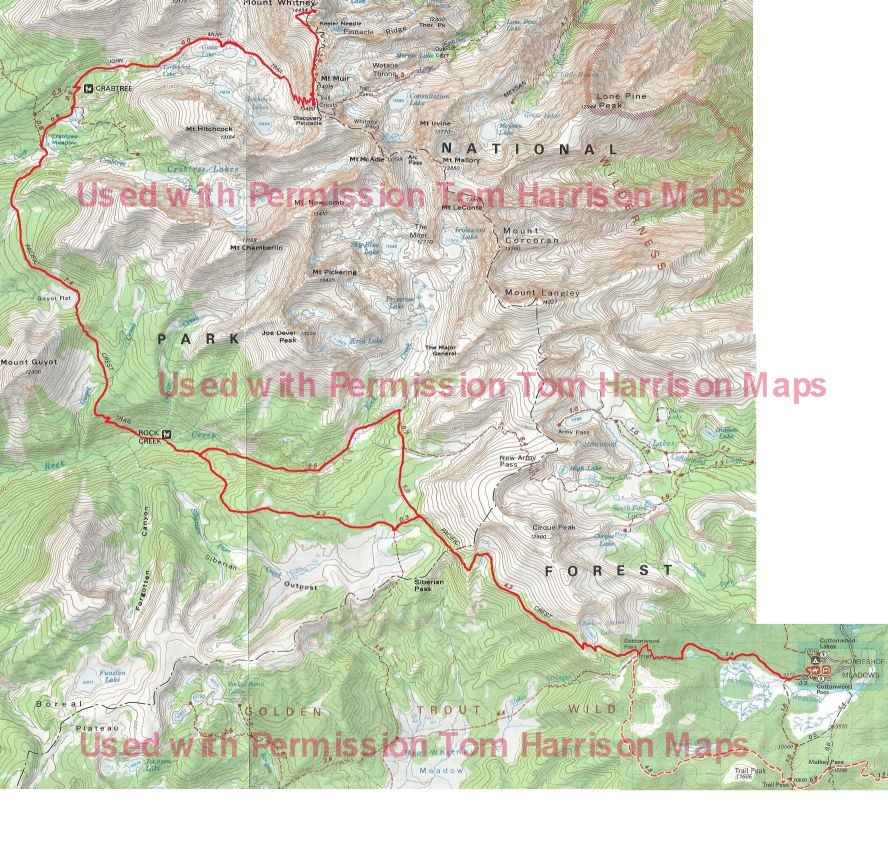
You can purchase quality topo maps at TOM HARRISON MAPS.
| |


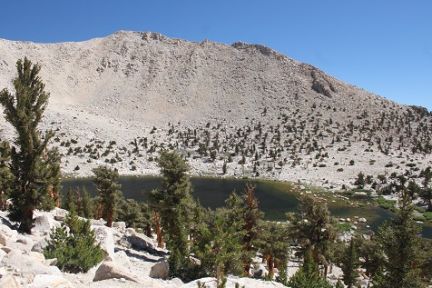 Chickenspring Lake
Chickenspring Lake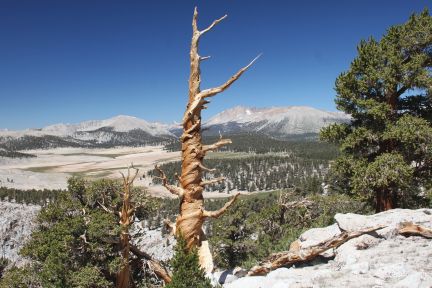 Overlooking Siberian outpost going from horseshoe meadow to Rock Creek"
Overlooking Siberian outpost going from horseshoe meadow to Rock Creek" 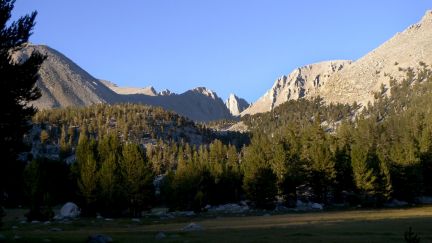 Crabtree Sunset
Crabtree Sunset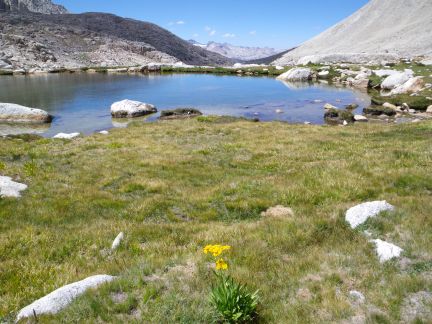 Guitar Lake
Guitar Lake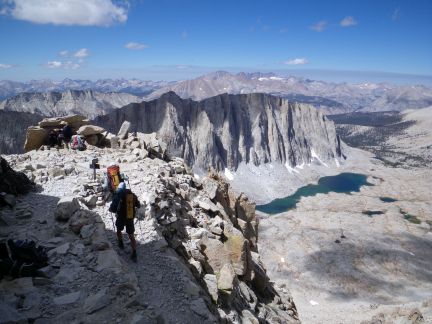
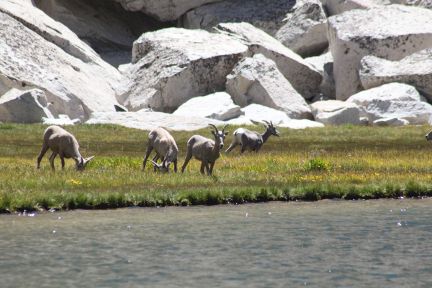 Chance for wildlife viewing at Soldier Lake...
Chance for wildlife viewing at Soldier Lake...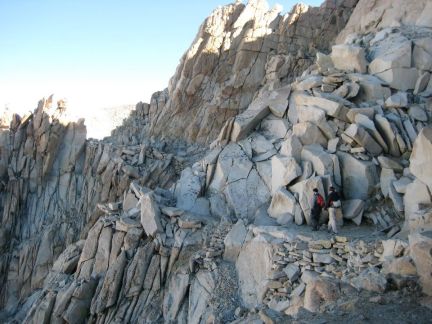
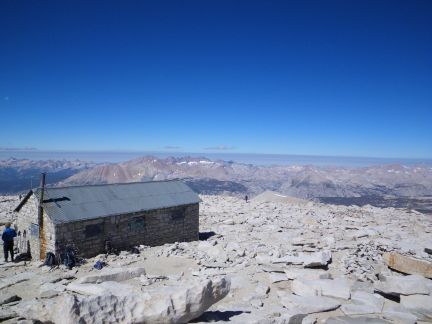
-campbell6x4.jpg) Looking Southwest from Mt. Whitney..
Looking Southwest from Mt. Whitney..
